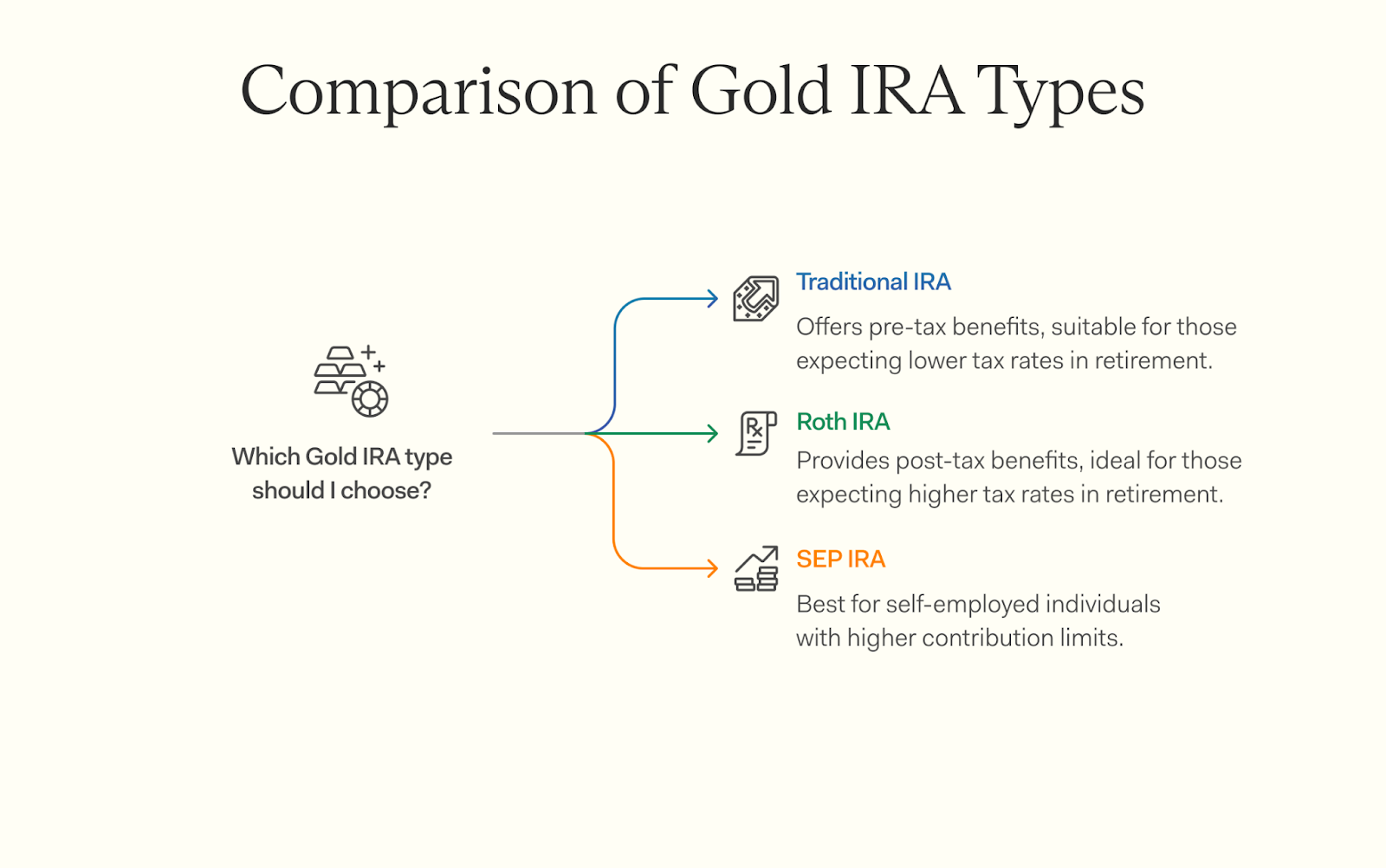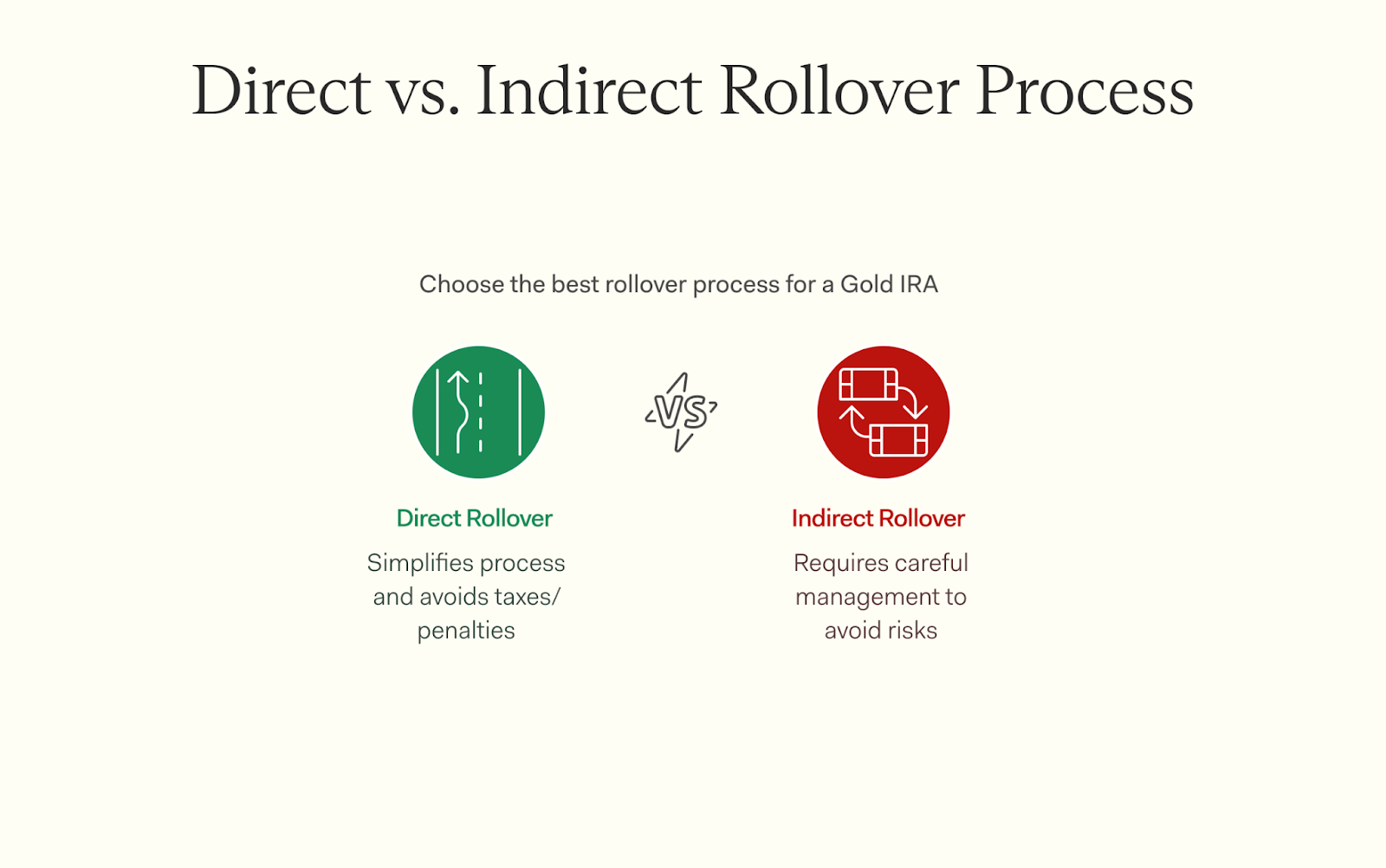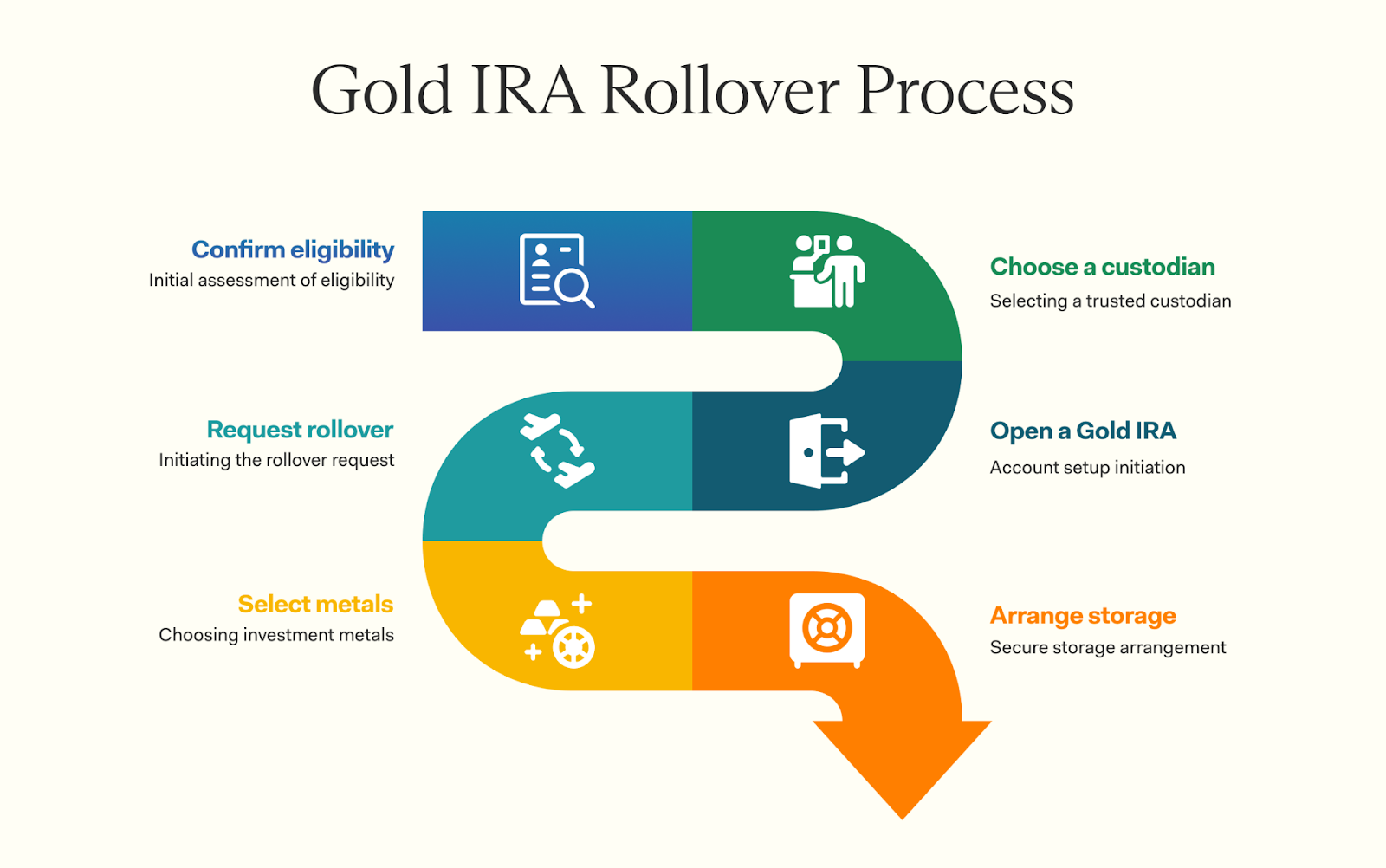Navigate the complexities of a Gold IRA rollover with our essential guide. Learn key strategies for a successful transition.
Is your retirement savings strategy missing a crucial element of protection? A Gold IRA rollover from your 401(k) might be the answer. Unlike traditional retirement accounts limited to stocks and mutual funds, Gold IRAs allow you to diversify with physical precious metals like gold and silver, adding a tangible layer of security to your portfolio.
Gold IRAs excel at preserving retirement wealth over the long term by providing a buffer against economic volatility and inflation.
This guide explores the benefits of converting your 401(k) to a Gold IRA, walks you through the straightforward rollover process, and highlights important pitfalls to avoid when securing your financial future with precious metals.

A Gold IRA lets you save for retirement with IRS-approved precious metals, including gold coins and bullion. This account differs from traditional IRAs that hold stocks and bonds by storing physical gold.
Owners can choose from Traditional, Roth, or SEP Gold IRAs, each offering specific tax benefits. Investing in a Gold IRA means your assets are tangible items like gold bars and coins kept in a secure location.
Converting your 401(k) to a Gold IRA adds security against market volatility and diversifies your retirement portfolio. This strategy helps safeguard your retirement funds by including gold investments, an asset less affected by economic uncertainty. Choosing a reputable gold IRA company is crucial for ensuring a smooth rollover process and optimal management of your retirement funds.
Gold can protect you from economic uncertainty. Many people invest in gold to keep their retirement savings safe during tough times. Unlike paper money, gold often holds its value. It does well when the economy is shaky or inflation rises.
A Gold IRA adds this layer of safety to your retirement account. You reduce risks by diversifying your portfolio with gold investments. This way, even if stocks drop, your gold may stay strong.
With a Gold IRA, you can hedge against loss and give yourself peace of mind in uncertain times… Next up is understanding what a Gold IRA really is.
Portfolio diversification means spreading your money across different types of investments. This strategy helps reduce risk. If one area, like stocks, drops in value, other assets can balance it out.
A Gold IRA offers a way to include gold and other precious metals in your investment mix.
Investing in gold can be a smart move during tough economic times. It often holds its value better than cash or stocks when markets are unstable. Adding gold to your retirement plan can protect against inflation and market swings.
A varied portfolio, including a Gold IRA, boosts long-term financial health while addressing risk tolerance directly.
A Gold IRA offers tax advantages that can benefit your savings. Contributions to a Traditional Gold IRA are often tax-deductible, which lowers your taxable income for the year. This means you pay less in taxes now and grow your investments tax-deferred until withdrawal.
With a Roth Gold IRA, contributions are made with after-tax money. You won't pay taxes on withdrawals during retirement if certain conditions are met. Both options help you save money over time, making them appealing choices for a tax-advantaged retirement account.
Gold IRAs come in different types, like Traditional, Roth, and SEP IRAs. Each type has its own rules and benefits.
A Traditional Gold IRA is a type of retirement account. It holds physical gold and other precious metals. Like any traditional IRA, it allows for tax-deferred growth. You don't pay taxes on the money until you withdraw it in retirement.
This can save you money over time.
You must use IRS-approved precious metals for this account. These include certain types of gold bullion and coins. Contribution limits are similar to those of regular IRAs. If you're eligible, you can roll over funds from your existing 401(k) into a Traditional Gold IRA without facing immediate taxes or penalties.
Next up, we'll look at Roth Gold IRAs and how they differ from traditional ones.
The Roth Gold IRA offers different tax benefits compared to its traditional counterpart. With a Roth Gold IRA, you contribute after-tax money. This means you won't pay taxes when you make withdrawals in retirement.
This can be very appealing for many investors.
You get to buy IRS-approved precious metals like gold or silver within this account. Just like with traditional IRAs, there are rules and limits on contributions. A key point is that earnings grow tax-free in a Roth Gold IRA.
Many see this as a smart choice for long-term investment and portfolio diversification.
A SEP Gold IRA is a retirement account for self-employed people or small business owners. It allows them to save money in gold and other precious metals. With this type of account, contributions are tax-deductible.
This means you can lower your taxable income while saving for retirement.
In a SEP Gold IRA, funds come from a Simplified Employee Pension (SEP) plan. You can roll over money from an existing 401(k) into this kind of account. This offers more control over how you invest, including buying IRS-approved gold and other investments.

Rolling over a 401(k) to a Gold IRA takes several clear steps. Start by confirming your eligibility and then choose a trusted Gold IRA custodian to help you through the process.
Before proceeding with a Gold IRA rollover, you need to check your eligibility. Not everyone can do this. Usually, you must have left your job or be at least 59½ years old. If you still work there, ask your plan administrator about the rules for rolling over funds.
Next, make sure your current 401(k) allows for a rollover into a gold IRA account. Some plans may not permit this transfer. Always review IRS rules regarding the rollover process as well.
This will help avoid any taxable withdrawal issues later on!
Finding a good gold IRA company or custodian is key. A reputable custodian helps you manage your gold investments safely. Look for one with a solid reputation and years of experience. Read reviews and check ratings from other clients.
Fees matter too—make sure they are clear and fair. Good customer support can make the process easier, especially if you have questions about your 401(k) to gold IRA transfer or IRS-approved precious metals.
Picking the right custodian sets a strong foundation for your tax-advantaged retirement account.
To open a Gold IRA account, start by selecting a reputable Gold IRA custodian. This is the company that will manage your account and hold your precious metals safely. Make sure the custodian has experience and good reviews.
Next, complete the application process with your chosen custodian. You'll provide personal details like your name, address, and Social Security number. Setting up an account can take just a few days.
After that, you can fund your new Gold IRA through direct rollover from your 401(k) or transfer funds from an existing IRA.
Choose IRS-approved precious metals for investment. These include gold bullion coins or bars that meet certain purity levels set by the IRS. Understanding these details helps ensure you're following gold IRA rules correctly while enjoying tax advantages along the way!
Requesting a direct rollover from your 401(k) is simple. You need to contact your 401(k) plan administrator. Ask them for the forms to start the rollover process. Fill these out carefully and specify that you want a direct transfer.
A direct rollover sends your money straight to your new Gold IRA. This way, you avoid taxes and penalties on early withdrawals. Make sure to keep all records of this transaction for future reference.
Doing it right ensures you move funds easily into a tax-advantaged retirement account without issues later on.
Selecting IRS-approved precious metals is key for a Gold IRA. The IRS only allows certain types of gold, silver, platinum, and palladium. This includes bullion coins like American Eagles and bars that meet specific purity levels.
Coins must be at least 99.5% pure gold to qualify.
Choosing the right metals protects your investment. Silver must also meet similar standards to be considered eligible. Investing in approved metals keeps tax advantages intact and avoids penalties with the IRS down the line.
You want to ensure every piece you buy fits these rules for your retirement plan's success!
You need to store your gold safely. Choose an IRS-approved depository for the best security. These facilities provide strong protection for your metals. They have insurance and strict controls to keep everything safe.
Some custodians offer storage options too. Make sure they use secure practices. Check their fees and terms before agreeing. It's important that you feel comfortable with how your assets are kept, especially since this is part of a tax-advantaged retirement account like a Gold IRA.
Keeping your gold in a safe place helps protect against theft or loss, which is key when rolling over from a 401(k) to a Gold IRA!
A direct rollover moves funds straight from your 401(k) to a Gold IRA. An indirect rollover gives you the cash first, but you must deposit it into the IRA within 60 days to avoid penalties, and you must also replace any amounts withheld by the plan administrator for taxes—typically 20%—to complete a full rollover and avoid taxes on the withheld amount.
Direct rollovers transfer your funds straight from a 401(k) to a Gold IRA. This method avoids taxes and penalties. The money goes directly into your new account, keeping it safe.
Indirect rollovers put the funds in your hands first. You receive a check and then have 60 days to deposit it into a Gold IRA, remembering to add back the 20% withheld for taxes. If you miss this 60-day window, you'll face income taxes and potential penalties on the entire distributed amount.
Both options have pros and cons—pick what suits your needs best as you move from a 401(k) to gold investments.
Rolling over your 401(k) into a gold IRA has clear pros and cons. A direct rollover lets you move funds without taxes or penalties, provided that the transfer is correctly handled between custodians. You can buy IRS-approved precious metals like gold, which can protect your savings from economic uncertainty.
This option keeps things simple.
On the flip side, an indirect rollover might seem easy but comes with the risks of mandatory 20% tax withholding and possible penalties if not completed within 60 days. Plus, it can lead to cashing out unintentionally if you're not careful.
Weigh these choices before making a decision on the right path for your tax-advantaged retirement account.
Rules for a Gold IRA rollover are key. You need to know what types of metals you can use and how much you can contribute. Storage must also meet certain standards. Following these rules helps you avoid costly mistakes.
Eligible precious metals for a Gold IRA include gold, silver, platinum, and palladium. These must meet IRS standards to be approved. For gold, American Gold Eagles are approved despite their 91.67% purity, while bars and other coins must be at least 99.5% pure. Canadian Maple Leafs must also meet the 99.5% purity standard for gold.
Silver must be 99.9% pure to be acceptable.
Common examples of IRS-approved metals are American Gold Eagles and Canadian Maple Leafs, which must be at least 99.5% pure for gold to ensure your investment aligns with tax-advantaged retirement accounts like a Gold IRA or self-directed IRA.
Check the list before making purchases to avoid buying unapproved metals.
Now, let's talk about contribution limits for a Gold IRA. For 2025, you can contribute up to $7,000 if you are under 50 years old. Those aged 50 and above can add an extra catch-up contribution of $1,000.
This means they can put in a total of $8,000.
These limits apply to all types of IRAs combined—whether it's a Traditional or Roth IRA. Contributions to a Traditional Gold IRA may be tax-deductible, depending on factors such as your income level and whether you participate in an employer-sponsored retirement plan. Keep these limits and conditions in mind as you plan your retirement investments!
Storage requirements are crucial for a Gold IRA. You must store your gold in an IRS-approved depository. This is to keep your investment safe and compliant with regulations.
You cannot just keep bullion at home. Storing it yourself is prohibited and could lead to the disqualification of your IRA, incurring taxes and penalties. The IRS mandates the use of an IRS-approved depository to hold precious metals. Choose a secure location that is an IRS-approved depository recommended by your custodian, ensuring that you meet the necessary standards for your Gold IRA account.
Choosing the right gold IRA company or custodian is key. Look for one with a good reputation and solid experience. Check their fees and see if they are clear about costs. Good customer support is a must too.
Look for a Gold IRA custodian with a strong reputation. Check reviews and ratings online. A respected custodian has years of experience in handling self-directed IRAs, especially gold IRAs.
They should understand IRS rules well.
Experience matters too. Find out how long they have been in business and how many clients they serve. A good track record shows they can handle your rollover funds properly. This can help you avoid mistakes along the way, like choosing unapproved metals or ignoring fees.
Fees and transparency are key when choosing a gold IRA custodian. You should know all costs before rolling over your 401(k) to a Gold IRA. Some custodians charge setup fees, annual maintenance fees, and transaction fees.
Make sure to get a clear breakdown of these charges.
A trustworthy custodian will be open about their pricing. They should also explain how they store IRS-approved precious metals securely. Always compare options to find the best deal for your tax-advantaged retirement account.
Understanding the fee structure helps you avoid surprises later.
Customer support makes your rollover process smoother. Look for custodians who offer help when you need it. They should guide you through each step.
Choose a custodian that has reachable and knowledgeable staff. You want answers quickly about your 401(k) to gold IRA rollovers or IRS-approved precious metals. Good communication is vital in handling questions on tax implications or storage requirements too.
The right support can make all the difference in managing your self-directed IRA effectively.

Many people make mistakes during a Gold IRA rollover. They often ignore IRS rules or choose metals that do not meet the requirements. This can lead to penalties and extra fees!
Ignoring IRS rules can lead to big problems. If you roll over a 401(k) to a Gold IRA without following the guidelines, you might face penalties. The IRS has strict rules about which metals are approved for your account.
Not every type of gold or precious metal qualifies.
Choosing unapproved metals could cost you more than just money. You risk having your IRA disqualified, leading to taxes and penalties on early withdrawals. Stay informed about IRS rules for eligible precious metals. It's crucial for a smooth rollover process.
Choosing unapproved metals can cause big problems for your Gold IRA. IRS rules state you must buy specific types of gold and other precious metals. Only IRS-approved metals qualify for this tax-advantaged retirement account.
Items like American Eagle coins, certain bars, and bullion meet the requirements.
Opting for wrong choices can lead to penalties or taxes on your rollover. Always check if the metal is approved before making a purchase. Adding unapproved items may risk your Gold IRA's status as a self-directed IRA.
Stick with what's allowed to keep your investment secure and profitable.
Fees for a Gold IRA can vary widely and are often overlooked. Some custodians charge high setup fees or yearly maintenance costs.
These expenses cut into your savings over time.
Always read the fine print. Look for hidden charges that might pop up during the rollover process. Compare different gold IRA custodians carefully. Focus on those with clear information about their fees.
Being aware of costs helps you avoid surprises and keeps your retirement account strong and growing.
Rolling over a 401(k) to a Gold IRA isn't just a smart move—it's a step toward financial resilience. By diversifying with gold, you shield your savings from economic uncertainty while strengthening your investment portfolio. The process is simple: find a trusted custodian, choose quality gold, and follow the rollover steps carefully.
Don't wait to secure your future. Take control, invest wisely, and build lasting wealth!
Rolling over a 401(k) to a gold IRA refers to the process of transferring funds from your workplace retirement plan, or 401(k), into an IRS approved self-directed Individual Retirement Account (IRA) that holds precious metals such as gold.
Contributions to a traditional Gold IRA may be tax-deductible, depending on your income and whether you or your spouse are covered by a workplace retirement plan. However, contributions to a Roth Gold IRA are made with after-tax dollars and are not tax-deductible.
A Gold IRA specifically allows you to invest in physical IRS approved precious metals. For investments in gold stocks or other securities, you would need to look into other types of IRAs, such as traditional or Roth IRAs.
Gold prices are crucial in determining the value of your Gold IRA holdings, as they are directly tied to the current market price of physical gold. However, it's important to bear in mind that gold prices are volatile; while your investment value can increase when prices go up, it can also decrease when prices fall.
While traditional IRAs typically invest in paper assets like stocks and bonds, self-directed IRAs, including Gold IRAs, can hold alternative assets such as IRS-approved precious metals. However, a Gold IRA is a specific type of self-directed IRA designed exclusively for holding physical gold and other precious metals.